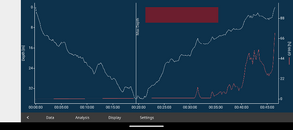johndiver999
Contributor
I can adjust how I plan my dives with the NDL of the computer accordingly. I'm curious, what does this statement mean? How do you think your computer is smarter?Hey guys! I have now done about 40 dives on my Tern TX and went into deco (?) with it for the first time. Well at least that's what the computer said during the dive. I didn't have to do an extended deco stop though as it cleared up during the ascent. In the beginning it stated 2 minutes at 6 meters though. Can someone please explain how exactly the algorithm works once i enter deco? I also dive with surface GF on my screen so I monitor where I am at anyways, but I somehow expected the computer to just stop me at a certain depth without taking into account any off gassing I did during the ascent. It seems like Shearwater computers are smarter than I originally expected and I can adjust how I plan my dives with the NDL of the computer accordingly.
Also, I think the answers you got already are correct, but perhaps are reinforcing a misconception - I think most (maybe all?) computers will do the exact same thing - in other words, if you do an "extra' slow ascent the deco ceiling will dissolve during the ascent and possibly at a depth well below the original deco stop. Assuming the required deco stop is relatively short and your ascent rate is within a certain range; neither too slow or too fast.




